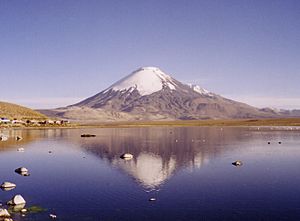Lake Chungará facts for kids
Quick facts for kids Lake Chungará |
|
|---|---|

Lake and Parinacota Volcano
|
|
| Location | Arica y Parinacota Region, Chile |
| Coordinates | 18°15′S 69°09′W / 18.250°S 69.150°W |
| Type | Natural |
| Primary inflows | Chungará, Sopocalane |
| Basin countries | Chile |
| Surface area | 21.5 km2 (8.3 sq mi) |
| Average depth | 33 m (108 ft) |
| Surface elevation | 4,517 m (14,820 ft) |
| Islands | none |
| Settlements | none |
Lake Chungará is a beautiful lake found in the very north of Chile. Its name comes from the Aymara language word chunkara, which means "moss on the stone."
This amazing lake is located in the Altiplano, a high plateau region in the Andes mountains. It's part of the Arica y Parinacota Region. Lake Chungará is one of the highest lakes in the world, sitting at about 4,517 m (14,820 ft) above sea level. It's the 29th highest lake globally and the 10th highest in South America!
Contents
Where is Lake Chungará Located?
Lake Chungará is surrounded by tall mountains and volcanoes. Two famous volcanoes nearby are Parinacota, which is about 6,342 m (20,807 ft) high, and Pomerape, about 6,222 m (20,413 ft) high.
The lake is inside Lauca National Park, a protected area in the Putre comuna. It's about 54 km (34 mi) east of the town of Putre. The lake is also quite close to the border with Bolivia, only about 9 km (5.6 mi) to the west.
What Animals Live in Lake Chungará?
Lake Chungará is home to some special kinds of fish. These fish are endemic to the lake's basin. This means they are found only in this lake and the streams that flow into it.
Some of these unique fish include:
These small fish have adapted to live in the cold, high-altitude waters of Lake Chungará.
Protecting Lake Chungará
Being part of Lauca National Park helps protect Lake Chungará and its unique wildlife. National parks are important because they keep natural places safe for plants and animals to live. They also allow people to visit and learn about these special environments.
The park helps make sure that the lake's water stays clean and that the animals, like the endemic fish, can continue to thrive.
Related pages
Images for kids
See also
 In Spanish: Lago Chungará para niños
In Spanish: Lago Chungará para niños









